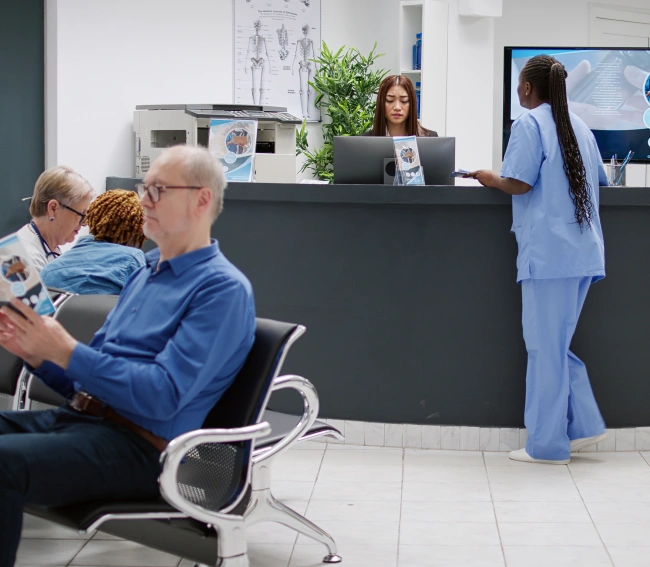Free Demo
Hospitals & Clinic Management System
- Home
- Solution for
Key Features
When choosing a Hospital ERP system, it's crucial to focus on the features that will enhance patient care and improve operational efficiency within your healthcare facility.

Super Admin
The Super Admin holds a powerful and critical role in hospital management software, overseeing various key functions. They are responsible for creating and managing all roles and permissions within the system, as well as maintaining profiles and documentation to ensure doctors have a clear understanding of each patient. The Super Admin links doctors and patients, sets up schedules, and manages hospital operations, including tracking discharges and updates. With exclusive access to all modules in the software, the Super Admin ensures seamless operation and efficient management across the hospital.
Key Features to Consider:
- User Role Management: Assign permissions based on predefined roles like administrator, user, or guest for streamlined access control.
- Permission Management: Offers precise control over actions and resources, ensuring users only access what they need.
- User Authentication: Strengthens security through multi-factor verification, ensuring only authorized users gain access.
- Audit and Compliance: Keeps comprehensive logs of user activities and access modifications to meet regulatory standards.
- Access Requests and Approvals: Allows users to request access to additional resources or roles with a clear approval process.

Admin Management
The primary authority for managing the entire Hospital Management System (HMS) rests with the Super Admin, while the Admin holds secondary authority. If the Super Admin grants full access, the Admin can oversee all hospital operations within the web application. This includes managing doctors, OPD & IPD, pharmacy, pathology, radiology, finance, inventory, and more. The Admin's roles and permissions are defined by the Super Admin, allowing them to carry out key functions within the limits set by the Super Admin’s guidelines.

Doctor Management
In addition to adding patients, doctors have access to a range of crucial information. They can view the schedules of fellow doctors, either fully or with certain restrictions, and also access a list of their patients. Doctors can see limited patient data such as medical history, treatment plans, notes, and any modifications to treatments. They also have full access to patient demographics and insurance details, alongside their own profiles and appointment schedules. The hospital management system is designed to streamline the management of both doctors and patients, ensuring smooth operations by tracking the availability of multiple doctors across different locations and enabling quick new patient registrations directly from the module.
Key Features to Consider:
- Pharmacy Management: Doctors can easily check the availability of medicines in stock and identify any new medications available in the pharmacy store.
- IPD & OPD Management: This module allows doctors to seamlessly manage both inpatient (IPD) and outpatient (OPD) care, ensuring efficient patient handling.
- Pathology Management: Efficiently manage the pathology department and easily access patient pathology reports within the system.
- Radiology Management: Doctors can effortlessly manage the radiology department and view patient radiology reports in a streamlined table format.
- Ambulance Management:This feature allows for efficient handling of ambulance services, including managing the ambulance list and adding detailed information.

Healthcare Accountant
Healthcare accounting is a specialized field that differs significantly from standard business accounting due to the complexities of patient payments, insurance, and revenue management. Healthcare providers must balance revenues, expenses, and assets to ensure financial stability. Effective accounting practices bring transparency, support critical decision-making, and provide optimal resource allocation. These elements are vital for managing operational costs and patient billing, making healthcare accounting both dynamic and essential.
Key Features of Effective Healthcare Accounting:
- Income & Expenses: Seamlessly track income and expenses to maintain financial clarity.
- Financial Management:Accountants handle procurement, billing, and insurance reimbursements, directly influencing a healthcare facility's operational efficiency.
- Tax Management: Accurate tax calculations based on local and international regulations to ensure compliance.
- Financial Reporting: Timely and accurate financial reporting allows for proactive identification of potential financial issues, enabling better resource management and mitigating larger risks.

Receptionist Role in Hospital Management System
When an admin assigns a user the role of a receptionist in the online hospital management system, the receptionist can log in using their designated username and password. The reception management system plays a critical role in managing visitors, appointments, and customer information at the front desk. With modern technology, it offers a contactless visitor check-in experience, replacing traditional paper logbooks, and improving the efficiency of front-office tasks. This system standardizes hospital operations, making them more streamlined and effective. The primary function of the receptionist panel is to register new patients and assign them to the appropriate doctor.
Key Features of an Effective Receptionist Management System:
- Appointment Management:The receptionist’s main responsibility is to manage and schedule appointments, ensuring that daily operations run smoothly without errors.
- Patient Flow Management: Receptionists are responsible for directing patients to the correct departments and addressing any inquiries they may have.
- Registration Process: When a patient arrives, the receptionist manages the registration process, including collecting contact information, securing identification documents (like a photo ID), and safeguarding the patient’s data.

Pharmacy Management
Pharmacy management software is a powerful digital tool designed to optimize pharmacy operations within hospitals and medical centres. Its primary function is to manage and deliver pharmaceutical drugs efficiently. Integrated with the broader hospital management system, this module allows doctors to prescribe medications based on current stock levels, while also notifying the inventory module when drugs need to be reordered.
Key Features of a Pharmacy Management Module:
- Medicine Import: The module simplifies bulk medicine imports. With the prescription model, users can easily upload large quantities of medicine data and download sample data files for quick uploads.
- Medicine Bill Generation: By entering basic details such as the medicine category, name, and quantity, the system can generate bills. The pharmacy module also tracks important details like the expiry dates of medicines.
- Stock Management: The pharmacy module helps manage the stock of medicines, including adding new medicines, checking inventory levels, and generating purchase requests for out-of-stock items.
- Pharmacy Store Management: This module boosts pharmacy productivity by simplifying workflows, managing inventory, processing insurance claims, and tracking the dispensing of all types of medicines. It streamlines stock management and ensures efficient pharmaceutical operations.

Pathology Management
The pathology module serves as a dynamic tool for managing and recording all laboratory tests and procedures. It streamlines the workflow of pathology labs by allowing both doctors and laboratory personnel to create and manage test requests. Designed to centralize hospital, clinic, and medical lab operations, this module integrates all relevant data into a unified system. It offers functionalities such as pre-booking tests, receiving requests online, test billing, and report delivery, making it an indispensable tool for modern healthcare facilities.
Key Features of the Pathology Module:
- Lab Requests Management: Handles diagnostic and investigation requests for inpatients, outpatients, and external labs efficiently.
- Test Categorization: Laboratory tests are organized into panels and profiles, ensuring seamless categorization and processing.
- Investigation and Results History:Maintains a detailed history of all investigations and test results, providing easy access to past data.
- Structured Workflow:Offers a structured worklist, ensuring optimal resource management and timely test processing.

Radiology Management
The Radiology module is designed to streamline all operations and tasks within the radiology department, playing a crucial role in medical imaging. This module aids radiologists and healthcare professionals in managing the acquisition, processing, analysis, and reporting of radiological tests and images. It tracks the status of tests, generates test reports, and provides seamless integration with patient medical records, allowing images and reports to be attached and viewed simultaneously. The user-friendly interface makes it easy for technicians to navigate the system and manage radiology services effectively.
Key Features of the Radiology Module:
- Appointment Scheduling: Streamlines the process of scheduling radiology appointments.
- Custom Report Preparation: Facilitates the creation of tailored radiology reports.
- Billing Integration:Simplifies billing for radiological services.
- Patient Registration:Efficiently manages patient registration for radiology services.
- Patient Management:Provides tools for managing patient lists and tracking their radiology history.
- Workflow Management:Optimizes the workflow of the radiology department, ensuring efficient use of resources and time.

Patient Management
Once a patient is onboarded, they are either transferred to IPD or OPD, depending on their care needs. The Patient Management module in the Hospital Management System (HMS) efficiently supports both inpatient and outpatient departments. This module records and stores vital information, including the patient's medical history, required treatments, past visits, upcoming appointments, reports, insurance details, and more. It also generates unique admission numbers for easy management of admissions, discharges, and transfers. A comprehensive discharge summary is created, ensuring a smooth discharge process. By storing and collecting patient details within the system, hospitals eliminate the need to gather information at every visit. This feature also allows for automated communication with patients and doctors sending appointment reminders, lab test follow-ups, and more leading to improved patient engagement and long-term relationships.
Key Features of the Patient Management System:
- Effortless Appointment Scheduling: Easily manage and schedule patient appointments.
- Comprehensive Patient Records: Store and access detailed patient information, including medical history.
- Patient Interaction Tracking: Monitor and track all patient interactions and touchpoints.
- Medical Transactions and Billing: Efficiently handle all medical transactions and billing processes.
Why Your Hospital or Clinic Needs a Clinic Management System
Our clinic management system offers a comprehensive, end-to-end solution to streamline everything from appointment scheduling to billing.

User-Friendly Interface:
Designed with a responsive, intuitive, and easy-to-use interface, ensuring a personalized experience for better user retention.

Financial Control:
Manage and monitor all financial operations, including profits, expenses, taxes, and outpatient billing, with full transparency.

Insurance Claims:
Integrated health insurance services provide patients with convenience while offering benefits to management.

Safe and Secure:
We prioritize security, ensuring the system is free from breaches and vulnerabilities.

Helpdesk & Support:
Efficiently handle requests, issues, and problems through a dedicated helpdesk, ensuring smooth operations and data reporting.
GLOBAL REACH
No matter where your business operates, we bring the expertise and experience to deliver top-tier hospital software at an affordable price.
ALL-INCLUSIVE SOLUTION
From managing OPD, IPD, appointments, pharmacy, labs, and bed management, to providing portals for doctors, patients, and staff









